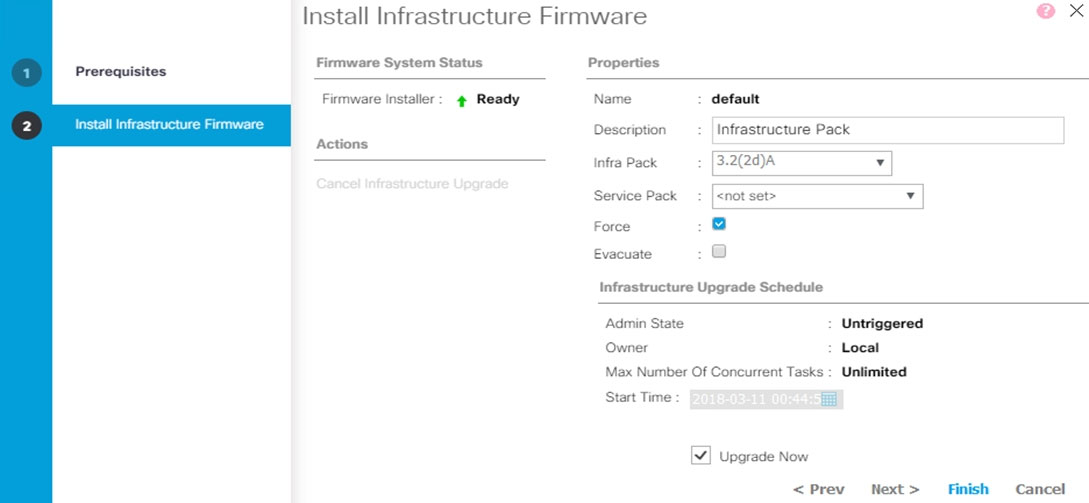An engineer wants to create a backup of Cisco UCS Manager for disaster recovery purposes.
What are two characteristics of a full state backup of a Cisco UCS Manager database? (Choose two.)
BE
Backup Types -
You can perform one or more of the following types of backups through Cisco UCS Manager:
Full stateג€"A binary file that includes a snapshot of the entire system. You can use the file generated from this backup to restore the system during disaster recovery. This file can restore or rebuild the configuration on the original fabric interconnect or recreate the configuration on a different fabric interconnect. You cannot use this file for an import.
Reference:
https://www.cisco.com/en/US/docs/unified_computing/ucs/sw/gui/config/guide/141/UCSM_GUI_Configuration_Guide_141_chapter43.html
What happens to the default host firmware policy after a Cisco UCS Manager upgrade?
A
After you upgrade Cisco UCS Manager, a new host firmware policy named "default" is created, and is assigned to all service profiles that did not already include a host firmware policy. The default host firmware policy is blank. It does not contain any firmware entries for any components.
Reference:
https://www.cisco.com/c/en/us/td/docs/unified_computing/ucs/ucs-manager/GUI-User-Guides/Firmware-Mgmt/3-1/ b_UCSM_GUI_Firmware_Management_Guide_3_1/b_UCSM_GUI_Firmware_Management_Guide_3_1_chapter_0111.html
An engineer is asked to use SaaS to manage Cisco computing.
Which two items are needed to accomplish the task? (Choose two.)
AE
Cisco Intersightג„¢ is a software-as-a-service (SaaS) hybrid cloud operations platform that delivers intelligent automation, observability, operations, and optimization to customers for traditional, cloud-native, and hybrid IT infrastructure and resources.
For Cisco infrastructure, the Intersight platform works in conjunction with Cisco UCS Manager, Cisco Integrated Management Controller (IMC), and Cisco
HyperFlex Connect.
Reference:
https://www.cisco.com/c/en/us/products/collateral/cloud-systems-management/intersight/intersight-ds.html
An engineer is configuring a backup operation on the existing Cisco UCS environment using a logical configuration.
Which configuration is expected to be saved by using this backup type?
D
Backup Types -
You can perform one or more of the following types of backups through Cisco UCS Manager:
ג€¢ Full stateג€"A binary file that includes a snapshot of the entire system. You can use the file generat-ed from this backup to restore the system during disaster recovery. This file can restore or rebuild the configuration on the original fabric interconnect, or recreate the configuration on a different fabric in-terconnect. You cannot use this file for an import.
ג€¢ All configurationג€"An XML file that includes all system and logical configuration settings. You can use the file generated from this backup to import these configuration settings to the original fabric in-terconnect or to a different fabric interconnect. You cannot use this file for a system restore.
ג€¢ System configurationג€"An XML file that includes all system configuration settings such as usernames, roles, and locales. You can use the file generated from this backup to import these con-figuration settings to the original fabric interconnect or to a different fabric interconnect. You cannot use this file for a system restore.
ג€¢ Logical configurationג€"An XML file that includes all logical configuration settings such as service profiles, VLANs, VSANs, pools, and policies. You can use the file generated from this backup to im-port these configuration settings to the original fabric interconnect or to a different fabric intercon-nect. You cannot use this file for a system restore.
Reference:
https://www.cisco.com/en/US/docs/unified_computing/ucs/sw/gui/config/guide/141/UCSM_GUI_Configuration_Guide_141_chapter43.html
An engineer is seeking the most optimal on demand CPU performance while configuring the BIOS settings of a UCS C-series rack mount server.
What setting will accomplish this goal?
A
When we are working on demand, we really do not know when we will have a spike and need to answer the requests quickly so working on C0/C1 will be suitable for this case.
C0 state ג€" The server provides all server components with full power at all times. This option maintains the highest level of performance and requires the greatest amount of power.
C1 state ג€" When the CPU is idle, the system slightly reduces the power consumption. This option requires less power than C0 and allows the server to return quickly to high-performance mode.
While C3, C6, and C7 could cause performance issues until the server returns to full power and it is not suitable for on-demand.
Reference:
https://www.cisco.com/c/en/us/products/collateral/servers-unified-computing/ucs-b-series-blade-servers/white-paper-c11-744678.html
An engineer is duplicating an existing Cisco UCS setup at a new site.
What are two characteristics of a logical configuration backup of a Cisco UCS Manager database? (Choose two.)
BC
Logical configuration ג€" An XML file that includes all logical configuration settings such as service profiles, VLANs, VSANs, pools, and policies. You can use the file generated from this backup to import these configuration settings to the original fabric interconnect or to a different fabric interconnect. You cannot use this file for a system restore.
Reference:
https://www.cisco.com/en/US/docs/unified_computing/ucs/sw/gui/config/guide/141/UCSM_GUI_Configuration_Guide_141_chapter43.html
Refer to the exhibit.
Which two Cisco UCS components are upgraded as a result of the configuration? (Choose two.)
AB
Install Infrastructure Firmware ג€" Uses the Cisco UCS Infrastructure Software Bundle to upgrade the infrastructure components, such as the fabric interconnects, the I/O modules, and Cisco UCS Manager.
Reference:
https://www.cisco.com/c/en/us/td/docs/unified_computing/ucs/sw/firmware-mgmt/gui/2-2/b_GUI_Firmware_Management_22/ b_GUI_Firmware_Management_22_chapter_0101.html
Which two settings must be configured before enabling a Cisco UCS Manager domain for Cisco Intersight connectivity? (Choose two.)
CE
Configure Administration Policiesג€"This step involves configuration of administration policies, such as DNS Server, NTP, and Time Zone, that are necessary for proper functioning of all components.
Reference:
https://www.cisco.com/c/en/us/td/docs/unified_computing/ucs/ucs-manager/GUI-User-Guides/Getting-Started/4-1/ b_UCSM_Getting_Started_Guide_4_1/b_UCSM_Getting_Started_Guide_4_1_chapter_0100.html
An engineer must configure Cisco IMC server management NIC for autonegotiation.
Which setting should be selected?
C
Auto-negotiation setting is only available in dedicated mode. This setting enables itself as long as a valid dedicated configuration is set.
Reference:
https://www.cisco.com/c/en/us/support/docs/servers-unified-computing/unified-computing-system/200221-Auto-negotiation-not-enabling-by- default.html
A network engineer is adding a Cisco HyperFlex data platform to the Cisco Intersight management portal.
Which two components are required for Intersight to claim the Cisco HyperFlex data platform? (Choose two.)
BD
In UCS Manager, browse to Admin -> Device Connector. Enable Intersight Management toggle button and get the Device ID and the Claim Code.
Reference:
https://www.cisco.com/c/en/us/support/docs/hyperconverged-infrastructure/hyperflex-hx-data-platform/214268-cisco-intersight-hyperflex-installatio.html